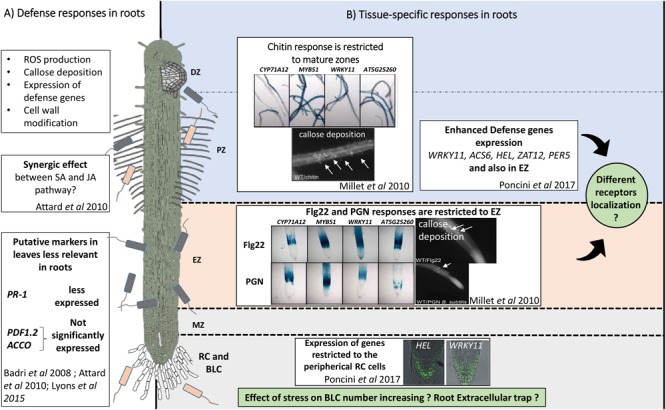FIGURE 1.

Overview of global and tissue-specific defense responses in Arabidopsis thaliana root. (A) Early PAMPs-triggered immunity (PTI) are common to leaves and roots. Production of ROS, callose deposition, an increase of defense genes leading to cell wall modification have been described in leaves and roots tissues. However, differences are noticed: the antagonistic effect of Salicylic acid (SA) and Jasmonic acid (JA) is not observed in A. thaliana root in response to Phytophthora parasitica infection (Attard et al., 2010). Markers of SA (PR-1), JA (PDF1.2) and ET (ACCO) expressed in leaves are also less relevant in roots (Badri et al., 2008; Attard et al., 2010; Lyons et al., 2015). (B) Root responses show tissue-specificity. In this schematic representation of a root, different zones can be distinguished: DZ, differentiation zone; PZ, root hair zone; EZ, elongation zone; MZ, meristematic zone; RC and BLCs, root cap and border-like cells. Millet et al. (2010), used various defense gene promotors in fusion to GUS in order to evaluate the defense gene expression in the different zone of the root after elicitation with various MAMPs. In response to chitin elicitation, gene expression occurred throughout the entire mature zones (DZ and PZ). In contrast, with Flg22 and PGN, the response is restricted to EZ. In this work, callose deposition was also studied. Furthermore, in root caps, it has been shown that in response to Flg22, expression of defense genes such as WRKY11 and HEL was restricted to the peripheral RC cells (Poncini et al., 2017). This compartmentalized response might suggest tissue-specific elicitor receptors localization. SA, Salicylic acid; JA, Jasmonic acid; ET, Ethylene; PR-1, Pathogenesis related proteins 1; PDF1.2, Plant defensin family 1.2; ACCO, Amino-cyclopropane-carboxylate oxidase myrosinase binding protein; CYP71A12, Cytochrome P450 family 71 polypeptide; MYB51, Transcription factor for the regulation of indole-glucosinolate biosynthesis; WRKY11, Negative regulator of basal resistance; AT5G25260, Nodulin-like protein of unknown function; ACS6 : 1-aminocyclopropane-1-carboxylate synthase 6; HEL, Hevein-like protein; ZAT12, Zinc-finger protein; PER5, Peroxidase superfamily protein; Flg22, Flagellin fragment of 22 amino-acid; PGN, Peptidoglycan.  : Pathogen microorganisms
: Pathogen microorganisms  : Beneficial microorganisms. Copyright by the American Society of Plant Biologists.
: Beneficial microorganisms. Copyright by the American Society of Plant Biologists.
